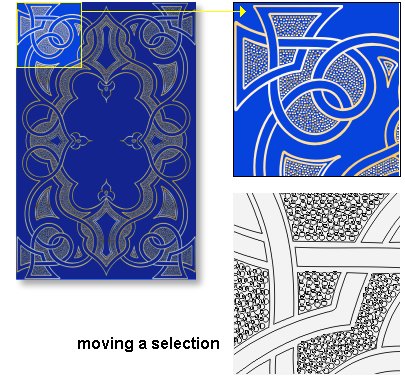The symptoms
We found that the direct, unbuffered output of some GDI primitives (i.e. the basic geometric shapes) via an HD 5870 or an HD 5750 was very slow compared to other cards under Windows 7. However, before we try to approach the causes, we should first look at the symptoms, because this is where the relevance for one or the other user group is first decided, and thus the question of whether one is affected or not. It’s not a problem that affects every user equally, but those whose software is struggling with the consequences of the restrictions become, in extreme cases, virtually spectators of an annoying slideshow.
 Marked selection of multiple objects: Moving this selection in real time can be a test of patience
Marked selection of multiple objects: Moving this selection in real time can be a test of patience
Problems with direct drawing
In principle, as we have already measured in the first part of the article, the output of lines, curves, ellipses and polygons is the most problematic. Also the fillings are not really implemented quickly. For example, we could only measure about 4000 curves per second for the HD 5870 when drawing directly to the output device under Windows 7 without its own buffer. If we move only one curve in real time with the help of the ROP, the total number of curves to be drawn already adds up to 50 with only 25 single steps per second (we remember the “make disappear” by drawing twice). Let’s just do the math. A simple object consists of 100 lines. In order to move this object smoothly for the eye, 25 movement steps per second would have to be drawn. Since we already need 2 drawing operations per step for the ROP, this results in a total of 5000 operations per second. A value that would then already be above the HD 5870’s limit. Ornaments and cliparts, however, consist for the most part of considerably more objects, so that a smooth movement of these objects (“float”) is no longer possible. The placement becomes a real game of chance and affects the productivity and functionality quite considerably.
Furthermore, many applications are so simple that the use of a buffer is not really considered appropriate as long as one can assume that the direct output is also within the usual performance limits. Especially these programs suffer visibly from speed losses.
Problems when drawing to a buffer
Even if programs use their own buffer and the number of certain geometry shapes becomes excessive, this can lead to a visible loss of performance and thus slow output. Especially since the blitting of the buffer contents is not very fast.
Exactly what kind of programs are affected?
All 2D programs that realize a drawing output via the GDI (and thus also run under Windows XP), if many drawing objects are to be output and if an editing option for graphical content exists (drawing programs, cover designers, planning programs, office programs)
What specific programs have we encountered problems with?
- Corel Draw, Adobe Illustrator, Adobe Freehand MX, Nemetschek Allplan (2D area)
- Adobe Photoshop CS3/CS4 (more extensive vector objects on different layers)
- MS Publisher, MS Powerpoint, various house planners in 2D design mode
- MS-Excel when outputting larger charts and editing large tables with fills
- Various tradesman solutions, such as string planning (electrical), plumbing and heating planning
- Industry solutions in the industrial sector (wall elements, floor plans, saw plans, etc.)
We would like to note that all listed programs already ran satisfactorily on conventional graphics cards and there are no arguments for buying an expensive Ati FireGL or Nvidia Quadro graphics card, when so far also LowCost cards in the range up to 50 Euro delivered good results. Tradesmen don’t buy special cards, nor do real estate offices.
Which programs are generally not affected?
- All 2D programs that realize a drawing output via Direct2D (and do not run under XP)
- All 3D programs that use Direct3D and do not output 2D content
- All programs that use OpenGL for 2D output
Conclusion and summary
You have to wait emotionlessly for the driver development and then decide whether the problems we have described could be relevant for you personally. It mainly affects the 2D performance under Windows 7 and is only acute if the 2D output is done via the GDI or GDI++. 2D software that also runs under Windows XP is therefore almost always affected by this problem. The performance is certainly sufficient for designing a small greeting card, but you should not want to postpone elaborate ornaments. Ultimately, therefore, the scope of the character content decides.
However, since the ATI HD 5750 is also affected, we also fear an analogous restriction for the smaller 5 series cards that will follow in the foreseeable future. These graphics cards are then bought less for gaming, but rather in combination with PCs for everyday work. And what that can mean in some cases is what we have tried to portray in this chapter. Even though it’s probably not a design flaw in the new cards, it can be a disaster for a user, at least in extreme cases. The drivers definitely need to be improved here, we’ll stay tuned.

































7 Antworten
Kommentar
Lade neue Kommentare
Urgestein
1
Urgestein
1
Neuling
Urgestein
Urgestein
Alle Kommentare lesen unter igor´sLAB Community →